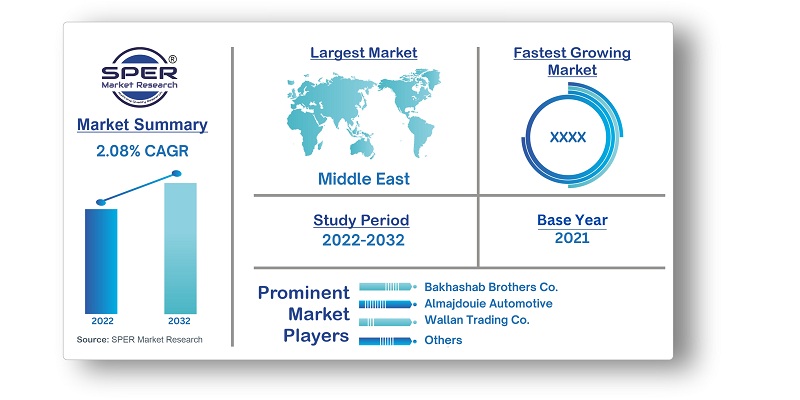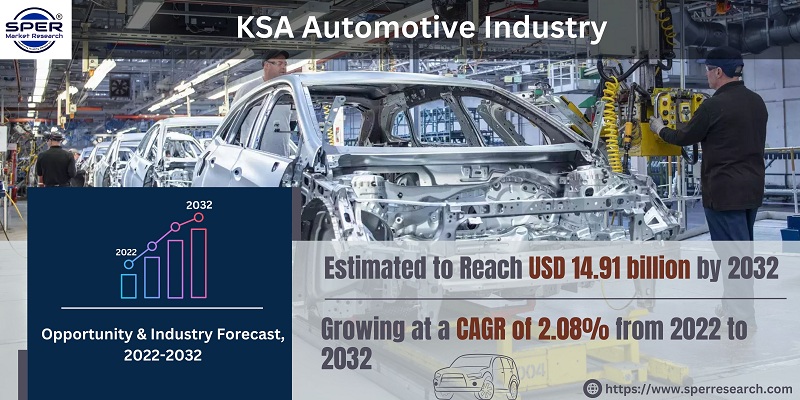
KSA Automotive Market Growth, Trends, Demand, Size, Revenue and Future Competition 2032
KSA Automotive Industry Size- By Type, By Motor Type, By Electric Vehicle, By Vehicle Type- Regional Outlook, Competitive Strategies and Segment Forecast to 2032
| Published: Jan-2023 | Report ID: AMIN2306 | Pages: 1 - 103 | Formats*: |
| Category : Automotive & Transportation | |||


| Report Metric | Details |
| Market size available for years | 2019-2032 |
| Base year considered | 2021 |
| Forecast period | 2022-2032 |
| Segments covered | By Type, By Motor Type, By Electric Vehicle, By Vehicle Type |
| Regions covered | Central Saudi Arabia, Eastern Saudi Arabia, Northern Saudi Arabia, Southern Saudi Arabia, Western Saudi Arabia. |
| Companies Covered | Abdul Latif Jameel Motors, Al Jazirah Vehicles Agency, Al Yemni Motors, Alesayi Motor Company, Alissa Universal Motors Co., Aljomaih Automotive Company, Almajdouie Automotive, Bakhashab Brothers Co., Haji Husain Alireza & Co., Juffali Automotive Company, Kia Al Jabr, Manahil International, Mohamed Yousuf Naghi Motors, Nissan Petromin, Universal Motors Agencies, Wallan Trading Co. |
- Bottom Dead Center
- Top Dead Center
- AC Induction Motor
- DC Brushless Motor
- Permanent Magnet Synchronous Motor
- Battery Electric Vehicle
- Hybrid Electric Vehicle
- Plug-in Hybrid Electric Vehicle
- Diesel Vehicle
- Electric Vehicle
- Fuel Cell Electric Vehicle
- Hybrid Electric Vehicle
- Central Saudi Arabia
- Eastern Saudi Arabia
- Northern Saudi Arabia
- Southern Saudi Arabia
- Western Saudi Arabia
- Size of KSA Automotive Industry (FY’2019-FY’2032)
- Overview of KSA Automotive Industry
- Segmentation of KSA Automotive Industry By Type (Bottom Dead Center, Top Dead Center)
- Segmentation of KSA Automotive Industry By Motor Type (AC Induction Motor, DC Brushless Motor, Permanent Magnet Synchronous Motor)
- Segmentation of KSA Automotive Industry By Electric Vehicle (Battery Electric Vehicle, Hybrid Electric Vehicle, Plug-in Hybrid Electric Vehicle)
- Segmentation of KSA Automotive Industry By Vehicle Type (Diesel Vehicle, Electric Vehicle, Fuel Cell Electric Vehicle, Hybrid Electric Vehicle, Mild Hybrid Vehicle, Natural Gas Vehicle, Petrol Vehicle, Plug-in Hybrid Electric Vehicle)
- Statistical Snap of KSA Automotive Industry
- Growth Analysis of KSA Automotive Industry
- Problems and Challenges in KSA Automotive Industry
- Competitive Landscape in the KSA Automotive Industry
- Impact of COVID-19 and Demonetization on KSA Automotive Industry
- Details on Recent Investment inKSA Automotive Industry
- Competitive Analysis of KSA Automotive Industry
- Major Players in the KSA Automotive Industry
- SWOT Analysis ofKSA Automotive Industry
- KSA Automotive Industry Future Outlook and Projections (FY’2019-FY’2032)
- Recommendations from Analyst
1.1. Scope of the report1.2. Market segment analysis
2.1 Research data source
2.1.1 Secondary data2.1.2 Primary data2.1.3 SPER’s internal database2.1.4 Premium insight from KOL’s
2.2 Market size estimation
2.2.1 Top-down and Bottom-up approach
2.3 Data Triangulation
4.1. Driver, Restraint, Opportunity and Challenges analysis
4.1.1 Drivers4.1.2 Restraints4.1.3 Opportunities4.1.4 Challenges
4.2. COVID-19 Impacts of the KSA Automotive Industry
5.1. SWOT analysis
5.1.1 Strengths5.1.2 Weaknesses5.1.3 Opportunities5.1.4 Threats
5.2. PESTEL analysis
5.2.1 Political landscape5.2.2 Economic landscape5.2.3 Social landscape5.2.4 Technological landscape5.2.5 Environmental landscape5.2.6 Legal landscape
5.3. PORTER’S five forces analysis
5.3.1 Bargaining power of suppliers5.3.2 Bargaining power of Buyers5.3.3 Threat of Substitute5.3.4 Threat of new entrant5.3.5 Competitive rivalry
5.4.Heat map analysis
6.1. KSA Automotive Industry Base Distribution, Sales Area, Product Type6.2. Mergers & Acquisitions, Partnerships, Product Launch, and Collaboration in KSA Automotive Industry
7.1. Bottom Dead Center7.2. Top Dead Center
8.1. AC Induction Motor8.2. DC Brushless Motor8.3. Permanent Magnet Synchronous Motor
9.1. Battery Electric Vehicle9.2. Hybrid Electric Vehicle9.3. Plug-in Hybrid Electric Vehicle
10.1. Diesel Vehicle10.2. Electric Vehicle10.3. Fuel Cell Electric Vehicle10.4. Hybrid Electric Vehicle10.5. Mild Hybrid Vehicle10.6. Natural Gas Vehicle10.7. Petrol Vehicle10.8. Plug-in Hybrid Electric Vehicle
11.1. KSA Automotive Industry Size and Market Share by Region (2019-2025)11.2. KSA Automotive Industry Size and Market Share by Region (2026-2032)11.3. Central Saudi Arabia11.4. Eastern Saudi Arabia11.5. Northern Saudi Arabia11.6. Southern Saudi Arabia11.7. Western Saudi Arabia
12.1. Abdul Latif Jameel Motors
12.1.1. Company details12.1.2. Financial outlook12.1.3. Product summary12.1.4. Recent developments
12.2. Al Jazirah Vehicles Agency,
12.2.1. Company details12.2.2. Financial outlook12.2.3. Product summary12.2.4. Recent developments
12.3. Al Yemni Motors
12.3.1. Company details12.3.2. Financial outlook12.3.3. Product summary12.3.4. Recent developments
12.4. Alesayi Motor Company
12.4.1. Company details12.4.2. Financial outlook12.4.3. Product summary12.4.4. Recent developments
12.5. Alissa Universal Motors Co
12.5.1. Company details12.5.2. Financial outlook12.5.3. Product summary12.5.4. Recent developments
12.6. Aljomaih Automotive Company
12.6.1. Company details12.6.2. Financial outlook12.6.3. Product summary12.6.4. Recent developments
12.7. Almajdouie Automotive
12.7.1. Company details12.7.2. Financial outlook12.7.3. Product summary12.7.4. Recent developments
12.8. Bakhashab Brothers Co
12.8.1. Company details12.8.2. Financial outlook12.8.3. Product summary12.8.4. Recent developments
12.9. Haji Husain Alireza & Co.
12.9.1. Company details12.9.2. Financial outlook12.9.3. Product summary12.9.4. Recent developments
12.10. Juffali Automotive Company
12.10.1. Company details12.10.2. Financial outlook12.10.3. Product summary12.10.4. Recent developments
12.11. Kia Al Jabr, Manahil International
12.11.1. Company details12.11.2. Financial outlook12.11.3. Product summary12.11.4. Recent developments
12.12. Manahil International
12.12.1. Company details12.12.2. Financial outlook12.12.3. Product summary12.12.4. Recent developments
12.13. Mohamed Yousuf Naghi Motors
12.13.1. Company details12.13.2. Financial outlook12.13.3. Product summary12.13.4. Recent developments
12.14. Nissan Petromin
12.14.1. Company details12.14.2. Financial outlook12.14.3. Product summary12.14.4. Recent developments
12.15. Universal Motors Agencies
12.15.1. Company details12.15.2. Financial outlook12.15.3. Product summary12.15.4. Recent developments
12.16. Wallan Trading Co.
12.16.1. Company details12.16.2. Financial outlook12.16.3. Product summary12.16.4. Recent developments
SPER Market Research’s methodology uses great emphasis on primary research to ensure that the market intelligence insights are up to date, reliable and accurate. Primary interviews are done with players involved in each phase of a supply chain to analyze the market forecasting. The secondary research method is used to help you fully understand how the future markets and the spending patterns look likes.
The report is based on in-depth qualitative and quantitative analysis of the Product Market. The quantitative analysis involves the application of various projection and sampling techniques. The qualitative analysis involves primary interviews, surveys, and vendor briefings. The data gathered as a result of these processes are validated through experts opinion. Our research methodology entails an ideal mixture of primary and secondary initiatives.



Frequently Asked Questions About This Report
PLACE AN ORDER
Year End Discount
Sample Report
Pre-Purchase Inquiry
NEED CUSTOMIZATION?
Request CustomizationCALL OR EMAIL US
100% Secure Payment






Related Reports
Our Global Clients
Our data-driven insights have influenced the strategy of 200+ reputed companies across the globe.




















